2021 Yamaha Tenere 700 Review - First Ride

Stateside at long last
We can hardly believe it. The long…no, interminably long wait is over. The 2021 Yamaha Ténéré 700 is finally on American soil. No, your eyes aren’t deceiving you. The motorcycle that fans of middleweight adventure touring motorcycles have been waiting for since 2016 is here. In case you doubt the sincerity of our excitement, we’ve written about the Ténéré 700 no less than 8 times here on MO. Back in May 2019, Ryan penned a thorough piece on his experiences riding the European model. Because of that, we’re not going to reinvent the wheel here. So, for the deep dive into the specifications and what it is that makes up the Ténéré, go to that story. Instead, the focus here will be on riding impressions and information not available at the time of the previous first ride.
2021 Yamaha Ténéré 700
| Engine | 18.5/20 |
| Suspension/Handling | 14.0/15 |
| Transmission/Clutch | 8.5/10 |
| Brakes | 7.5/10 |
| Instruments/Controls | 4.0/5 |
| Ergonomics/Comfort | 8.0/10 |
| Appearance/Quality | 9.0/10 |
| Desirability | 9.5/10 |
| Value | 9.0/10 |
| Overall Score | 88/100 |
2020 Yamaha Tenere 700 Review – First Ride
To illustrate how important this motorcycle is to Yamaha, the media department gathered select publications for our online press briefing, which was followed by a small, socially-distanced introductory ride a few days later. Clearly, Yamaha doesn’t want a global pandemic to delay getting the word out on its newest adventure tourer.
If I had to pick a theme for the briefing, it would have to be an emphasis on off-road capability, with the T7 being referred to several times as the “The lightweight, go anywhere adventure motorcycle.” In order to achieve this stated goal, the Ténéré needs both street polish to get the rider to and from the remote roads/trails that constitute “go anywhere.” Once there, it needs to be capable of handling whatever the off-road environment throws at it.
Another area that Yamaha focused on was reliability, and it is true. Ténérés have a deserved reputation for being solidly built and being capable of running over the long haul with minimal fuss. If there were a well-known weakness in the genes, it would be what we encountered in our 2016 Wire-Wheel Adventure Shootout, where Dirty Sean Alexander managed to poke, not one but two, holes in the oil pan of the Super Ténéré ES, proving that plastic bash plate-looking pieces don’t offer real protection when you need it. Naturally, the Ténéré 700 comes with proper aluminum bottom end protection. This along with the 21-inch front and 18-inch rear wheels mated to a proper dirt suspension with 8 inches of clearance front and rear illustrate that Yamaha plans on backing up its claims.
On the Road
Unless you’re fortunate enough to live on a ranch bordering on National Forest land, your adventure tours necessarily begin with a street ride. How extended it is depends on your location and goals for the trip. In our case, we only had an hour or so (both ways) of paved travel before what Yamaha termed a “proper dirt ride.” In that time, however, we got to sample around town riding, a smidge of freeway, and an extended jaunt on some circuitous mountain roads.
With the engine – with the exception of the intake, exhaust, radiator, and final drive – being lifted directly from the popular MT-07 (a three-year concurrent Best Value Motorcycle of the Year winner), it should come as no surprise to learn that the T7’s mill is perfectly happy to troll around town or on rural highways. While the shorter final drive may make you shift a little sooner, the engine remains vibration-free until you reach above 7,000 rpm. Cruising along on the interstate at 80 mph? How does about 6,100 rpm sound? The slick transmission is happy with old-school clutchless upshifts, and the throttle response, except in the extreme low rpm where some abruptness and driveline lash are noticeable, is impeccable. Riders who rack up a lot of miles will like the 24,000-mile valve-adjustment interval.
Wind protection is better than one might expect, given the windscreen’s size, but it struck the right compromise between cooling air-flow and tiring wind blast. Even at 80 mph, turbulence was essentially nil at the top of my 5-foot, 11-inch height. The only thing that would give me pause before crossing a western state is the lack of cruise control even as an option. (Heated grips are available from the accessory catalog, though.)
Another area that appears spartan at first glance is the LCD instrumentation, but if you dig a little deeper, you’ll understand Yamaha’s choice. The vertical orientation and size are inspired by rally motorcycles and is designed to make it easy to capture the important information at a glance while standing on the pegs in rough terrain. The information delivered also reflects its off-road roots. For example, you get a count-down trip meter. Above the easy-to-read screen, Yamaha included a bar for mounting other devices, like a GPS or a roadbook.
While the 34.4-inch seat height screams dirt bike, it also spells for a roomy riding position on the street. With a just-about-perfect rider triangle for racking up miles, I could easily see myself spending multiple days on the road in the saddle. Speaking of the saddle, while it is clearly designed with off-road utility in mind, I didn’t feel like it gave up too much in highway comfort. The seat’s narrowness allows for a multitude of butt positions if any one should get uncomfortable.
As with any adventure tourer when its suspension is set for street comfort, the Ténéré has a fair amount of chassis pitch and rewards smooth riding when corners are encountered. Bend the specially-built chassis into a corner with an arching line, and you’ll be rewarded with surprisingly good cornering performance. The Pirelli Scorpion Rally STR tires get credit here alongside the suspension. While the Scorpions won’t be mistaken for dedicated sport-touring rubber, if you can get beyond the somewhat vague feedback from the front end on pavement, toe-scraping lean angles are achievable. This is pretty impressive when you consider that the 21-inch front and 18-inch rear wheels are clearly for the dirt portion of the riding equation. Steering is surprisingly easy, thanks to the wide handlebar.
About the Brakes
The first time you use the brakes in anger on the Ténéré is likely to be a shock. There is a fair amount of initial travel of the front brake lever, and the braking power comes on gradually, although in a very linear fashion. Before you go and start crying “crap brakes,” consider the reasoning behind this decision. This is a feature, not a bug, that Yamaha calls “controllable first touch performance.” Simply put, the designers want riders to have maximum feel and control over on- and off-road brake application. However, what you gain in old-school, analog brake feel, you lose in electronic aids. While the Ténéré has ABS for the road, there are no off-road specific ABS modes. Instead, Yamaha offers an easy-to-access ABS off button.
On the street, the dual 282mm front discs and Brembo two-piston calipers delivered the power I needed when asked, and once I got used to them, I was able to make quick work of any winding section of road that we encountered. For those who are concerned that my comments mean that the brake system is underpowered on the street, the binders have more than enough power to haul the bike down from speed in a panic-stop situation.
Getting Dirty
Now that we’re about to focus solely on the dirt capabilities of the Ténéré 700, I feel it is necessary to acknowledge my strange affinity for the ground when riding in the dirt ( here, here, and here). To sum it up, I’m a mid-level dirt rider at best, and you may be wondering why someone with my skill set is evaluating a bike that Yamaha wants to sell on its dirt capabilities. Well, Ryan, MO’s most skilled dirt rider, has already ridden and commented on the Ténéré last year. The other reason is that adventure riders cover a wide variety of skill sets. So, why not see what a rider of more average capabilities can do on the bike – particularly since it lacks the electronic aids that help less experienced off-road riders muster up the courage to take their adventure bikes beyond the confines of paved roadways.
So, there I was, the least experienced dirt rider in a group of professionals – or at least riders of much more advanced capabilities than myself. I survived and only tasted the indignity of the ground twice, thankfully with no cameras around.
What matters to less experienced off-roaders piloting a 452 lb. (claimed) adventure motorcycle is forgiveness. How many mistakes can be recovered from, how many obstacles can be surmounted, and how many fears faced? In the end, despite the soil samples and abject terror in a couple of instances, the Ténéré taught me a few things. First, it crashes really well. Where I’ve seen other adventure bikes’ plastic handguards frag on the slightest tip over, the T7’s took the abuse with aplomb – including one impact which involved catching the front wheel in a rut at about 15 mph and instantly tossing me and the bike on our sides. The result was slight scratching on both the right handguard and the muffler (and continued embarrassment for me).
In those instances where I was actually riding the Ténéré instead of lying beside it, the engine impressed me with its flexibility. It was more than happy to chug along, lugging its way over terrain that had me at the limits of my ability. In fact, I spent most of the day in second gear – even from a stop – because of the engine’s low-speed tractability. Despite spending most of its time in the low rpm numbers, it didn’t mind revving out when the dirt turned to a graded fire road, and I gained my confidence. The throttle was easy to modulate, and the lurch that I noticed on the street at low rpm was a non-issue in the dirt. While the Ténéré has no traction control, I found rear wheel spin to be easy to control, thanks to the predictable throttle.
If you’ve spent any time in the dirt, you know how important it is to be able to feather the clutch to keep the rpm up when working your way over rocks and the like. The T7 took all of this with a grace that boosted my confidence.
The technological support I was most concerned about not having on the Ténéré was ABS on the front wheel. When thinking about the ride beforehand, I had visions of doing a sandy descent in front of the video and still photographers and locking the front wheel to familiar results. Instead, the front brake that required some getting used to on the street was a lifesaver in the dirt. I could feel what the front tire was doing and mete out the appropriate level of force that the situation warranted, be I approaching a corner that I needed to slow down on or negotiating a complicated (for me) downhill section.
Although I wasn’t jumping the Ténéré, I did manage to use an extensive amount of the suspension travel just by riding within my capabilities. This shouldn’t come as a surprise since I occasionally rode over obstacles that a more talented rider would have been able to circumvent, but it was nice to know that the T7 had my back.
The girth of many adventure tourers strikes fear in the hearts of many riders when it comes time to leave the tarmac behind. Although the Ténéré felt like more than 452 lb. when lying on my leg, it felt fairly light and controllable when I was in the appropriate riding position. In fact, it was the confidence inspired by its maneuverability that put my front wheel in the rut, causing my hardest crash of the day. I’d just told myself that I was really getting the hang of things when it happened. Famous last words.
Back in One Piece
After waiting so long for the Ténéré 700 to arrive in the states, you’ll need to wait a little bit longer to see how it performs compared to the rest of the middleweight adventure touring class. My opinion is that, in terms of outright off-road performance, it will weigh in a tad below the KTM 790 Adventure R, and that’s not a bad thing. With an increased focus on performance, there often comes a penalty to those who lack the skills to exploit it to its limits. Instead, I feel that there is something to be said for the ridability – for forgiveness if you will – offered by a bike that delivers a more balance package performance-wise. The other huge selling point for the Ténéré is its impressive $9,999 price tag. Yes, that means you miss out on some features like TFT screens and electronic rider aids, but the Ténéré delivers a combined on- and off-road package that provides a tremendous value for the money.
The 2021 Yamaha Ténéré 700 is available in June at your local dealerships. The color options are Ceramic Ice, Intensity White, and Matte Black, and Yamaha has an extensive line of accessories, including suspension- and seat-lowering options, already available. If you’re in the market for a middleweight adventure touring bike, this is a very good time to be a motorcyclist. We can’t wait until we can do our shootout!
2021 Yamaha Ténéré 700
+ Highs
- Streetable utility combined with dirt capability
- That CP2 engine!
- Less than $10,000
– Sighs
- Mediocre street braking power
- No electronics suite
- The 34-inch seat may be off-putting for some
In Gear
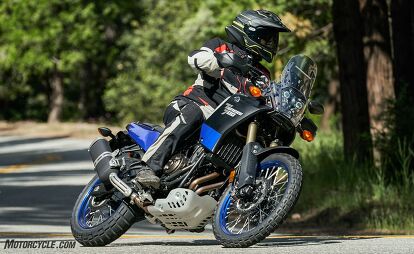
- Helmet: Shoei Hornet X2 $716
- Suit: Spidi 4Season H2Out Jacket $950
- Boots: TCX Baja Gore-Tex $370
Gloves: Alpinestars SP X Air Carbon V2 $100
2021 Yamaha Ténéré 700 | |
|---|---|
| MSRP | $9,999 |
| Engine Type | 689cc liquid-cooled Parallel Twin |
| Bore and Stroke | 80.0mm x 68.6mm |
| Fuel System | EFI |
| Compression Ratio | 11.5:1 |
| Valve Train | DOHC; 8 valves |
| Transmission | 6-speed; wet multiplate clutch |
| Final Drive | Chain |
| Front Suspension | 43mm inverted fork, fully-adjustable; 8.3-inches travel |
| Rear Suspension | Single shock, adjustable preload (w/remote adjuster) and rebound damping; 7.9-inches travel |
| Front Brake | Dual 282mm hydraulic disc; selectable ABS |
| Rear Brake | 245mm hydraulic disc; selectable ABS |
| Front Tire | 90/90R21 Pirelli Scorpion Rally STR |
| Rear Tire | 150/70R18 Pirelli Scorpion Rally STR |
| Rake/Trail | 27°/4.1 inches |
| Wheelbase | 62.8 inches |
| Seat Height | 34.4 inches |
| Curb Weight | 452 pounds (claimed) |
| Fuel Capacity | 4.2 gallons |
| Available Colors | Ceramic Ice; Intensity White; Matte Black |

Like most of the best happenings in his life, Evans stumbled into his motojournalism career. While on his way to a planned life in academia, he applied for a job at a motorcycle magazine, thinking he’d get the opportunity to write some freelance articles. Instead, he was offered a full-time job in which he discovered he could actually get paid to ride other people’s motorcycles – and he’s never looked back. Over the 25 years he’s been in the motorcycle industry, Evans has written two books, 101 Sportbike Performance Projects and How to Modify Your Metric Cruiser, and has ridden just about every production motorcycle manufactured. Evans has a deep love of motorcycles and believes they are a force for good in the world.
More by Evans Brasfield



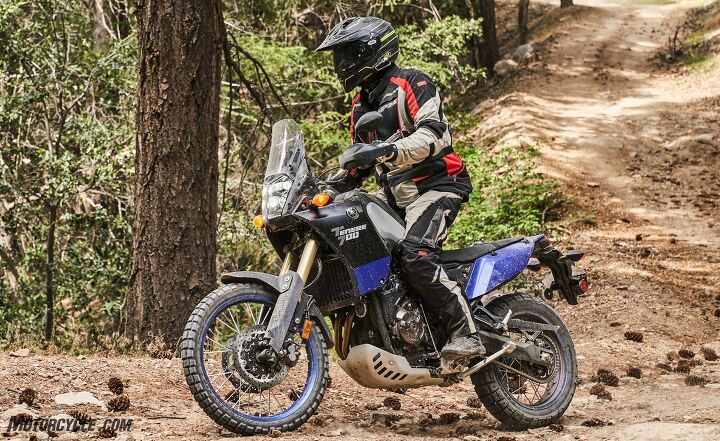











































































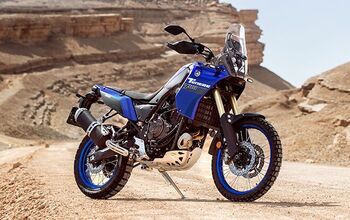
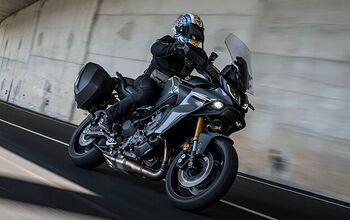
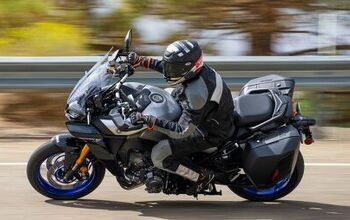












Comments
Join the conversation
I really like the new Honda CBR 450 L especially at only 289 pounds wet!!!!
Next time you're on a Yamaha launch, ask the genius who designed the left-hand switch gear on the FZ-07 why he or she put the horn button where the turn signal button is supposed to be. I hope they haven't killed or injured any riders with that confusing BS.